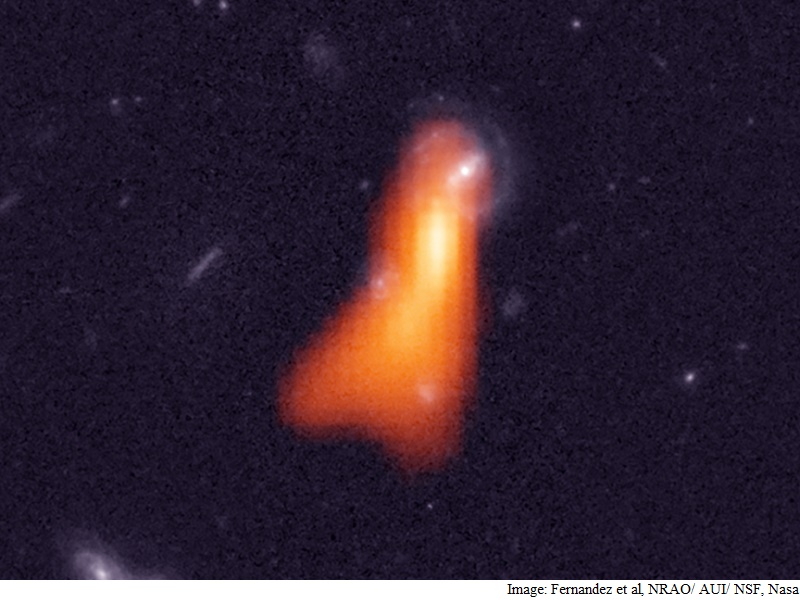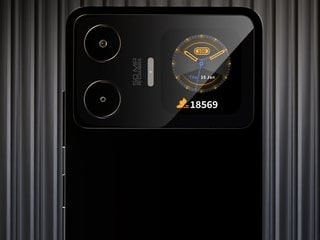- Home
- Science
- Science News
- Astronomers Detect Hydrogen in Galaxy More Than 5 Billion Light Years Away
Astronomers Detect Hydrogen in Galaxy More Than 5 Billion Light-Years Away

Using the Very Large Array radio telescope of the National Radio Astronomy Observatory in the US, the team observed radio emission from hydrogen in a distant galaxy and found that it would have contained billions of young, massive stars surrounded by clouds of hydrogen gas.
As the most abundant element in the universe and the raw fuel for creating stars, hydrogen is used by radio astronomers to detect and understand the makeup of other galaxies.
However, until now, radio telescopes have only been able to detect the emission signature of hydrogen from relatively nearby galaxies.
"Due to the upgrade of the Very Large Array, this is the first time we've been able to directly measure atomic hydrogen in a galaxy this far from Earth," said lead author, Dr Ximena Fernandez from Rutgers, the State University of New Jersey.
"These signals would have begun their journey before our planet even existed, and after five billion years of travelling through space without hitting anything, they've fallen into the telescope and allowed us to see this distant galaxy for the very first time," he added.
The success for the team comes after the first 178 hours of observing time with the Karl G. Jansky Very Large Array (VLA) radio telescope for a new survey of the sky called the 'COSMOS HI Large Extragalactic Survey' or CHILES.
Once completed, the CHILES survey will have collected data from more than 1,000 hours of observing time.
In a new approach, members of the team including Dr Attila Popping from International Centre for Radio Astronomy Research and the ARC Centre of All-sky Astrophysics (CAASTRO) in Australia are working with Amazon Web Services to process and move the large volumes of data via the "cloud".
"For this project, we took tens of terabytes of data from the Very Large Array and then processed it using Amazon's cloud-based servers to create an enormous image cube, ready for our team to analyse and explore," Dr Popping added.
Professor Andreas Wicenec, head of the Data Intensive Astronomy team at the International Centre for Radio Astronomy Research, said the limiting factor for radio astronomers used to be the size of the telescope and the hardware behind it.
"It's fast becoming more about the data and how you move, store and analyse vast volumes of information," he said in a paper published in the Astrophysical Journal Letters.
Catch the latest from the Consumer Electronics Show on Gadgets 360, at our CES 2026 hub.
Related Stories
- Samsung Galaxy Unpacked 2025
- ChatGPT
- Redmi Note 14 Pro+
- iPhone 16
- Apple Vision Pro
- Oneplus 12
- OnePlus Nord CE 3 Lite 5G
- iPhone 13
- Xiaomi 14 Pro
- Oppo Find N3
- Tecno Spark Go (2023)
- Realme V30
- Best Phones Under 25000
- Samsung Galaxy S24 Series
- Cryptocurrency
- iQoo 12
- Samsung Galaxy S24 Ultra
- Giottus
- Samsung Galaxy Z Flip 5
- Apple 'Scary Fast'
- Housefull 5
- GoPro Hero 12 Black Review
- Invincible Season 2
- JioGlass
- HD Ready TV
- Laptop Under 50000
- Smartwatch Under 10000
- Latest Mobile Phones
- Compare Phones
- OPPO A6c
- Samsung Galaxy A07 5G
- Vivo Y500i
- OnePlus Turbo 6V
- OnePlus Turbo 6
- Itel Zeno 20 Max
- OPPO Reno 15 Pro Mini 5G
- Poco M8 Pro 5G
- Lenovo Yoga Slim 7x (2025)
- Lenovo Yoga Slim 7a
- Realme Pad 3
- OPPO Pad Air 5
- Garmin Quatix 8 Pro
- NoiseFit Pro 6R
- Haier H5E Series
- Acerpure Nitro Z Series 100-inch QLED TV
- Asus ROG Ally
- Nintendo Switch Lite
- Haier 1.6 Ton 5 Star Inverter Split AC (HSU19G-MZAID5BN-INV)
- Haier 1.6 Ton 5 Star Inverter Split AC (HSU19G-MZAIM5BN-INV)

















